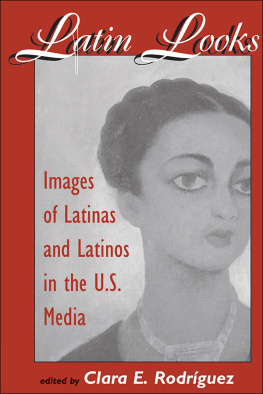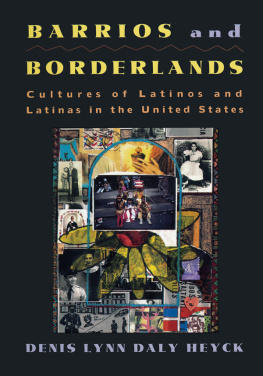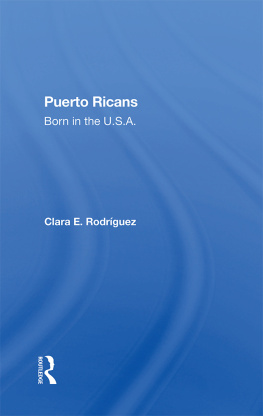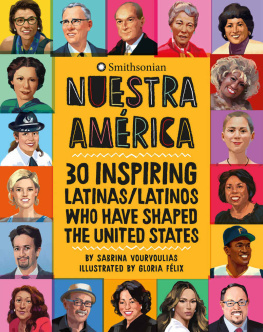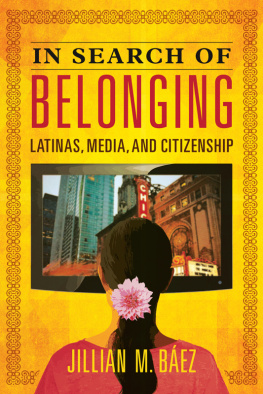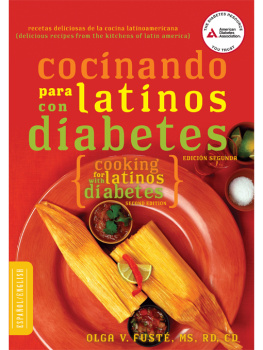First published 1997 by Westview Press
Published 2018 by Routledge
711 Third Avenue, New York, NY 10017, USA
2 Park Square, Milton Park, Abingdon, Oxon OX14 4RN
Routledge is an imprint of the Taylor & Francis Group, an informa business
Copyright 1997 Taylor & Francis
All rights reserved. No part of this book may be reprinted or reproduced or utilised in any form or by any electronic, mechanical, or other means, now known or hereafter invented, including photocopying and recording, or in any information storage or retrieval system, without permission in writing from the publishers.
Notice:
Product or corporate names may be trademarks or registered trademarks, and are used only for identification and explanation without intent to infringe.
Library of Congress Cataloging-in-Publication Data
Latin looks: images of Latinas and Latinos in the U.S. media / edited by Clara E. Rodriguez
p. cm.
Includes bibliographical references (p. ) and index.
ISBN 0-8133-2765-2.ISBN 0-8133-2766-0 (pbk.)
1. Hispanic Americans and mass mediaUnited States.
I. Rodriguez, Clara E., 1944.
P94.5.H582U65 1997
305.868073dc2197-1840
CIP
ISBN 13: 978-0-8133-2766-2 (pbk)
What are Latin looks? At first blush, it seems that there is a Latin or Latino look that everyone recognizes. This person is slightly tan, with dark hair and eyes. Upon further thought, we find other factors that contribute to the Latin look, for example, Spanish usage, accented English, occupation, education, residence, relationship to Anglos, self-identification, and identification by others. But does this image accurately reflect Latinos and their history in U.S. media? The more I reflect on these questions, the more I would say thatas the authors of many of the chapters in this volume argueLatin looks are to a considerable extent determined by political, economic, and historical contexts, and the images are often at variance with current and past Latino realities.
Victoria Medina, founder and president of The Studio, an organization in New York City established to help Latinos in the business of acting, illustrated the difference between realities and images in an anecdote (personal communication, March 22, 1995). When a casting call went out for an actress to play a Latina part, three genuine Latinas showed up. One was fair-skinned, blond, and tall. Another was tan and of medium build and had dark hair and eyes. The third had darker skin and was of African descent. These three genuine Latinas represented the heterogenous reality of Latinos in the United States. This is the reality that surfaces when a casting call goes out with the generic term Latina attached. Yet, those who present Latinos on the screen seek certain images. By the same token, those who satisfy Latino images are not viewed as appropriate for other (nonethnic) parts. Victoria Medinas conclusion? She believes it is unfair to specify one Latino look. Instead, the right person should be cast for each particular role.
In 1995, The Hollywood Reporter, in a survey of Hollywoods most bankable stars, listed Rosie Prez as the second most popular Hispanic star (Andy Garcia was the first) (Avila, 1996:26). Among my undergraduate students at Fordham University in New York City, Prez is without a doubt the best-known and most frequently identified Latina actress in Hollywood today. But her name invariably elicits extreme reactions especially from Latina students. One response is that she is an embarrassment to her race. In other words, her image, the way she projects herself, her manner of speech and dress, and her general style are viewed as embarrassing to other Latinos. (Some Latinos are concerned that all Latinas will be judged by the image Prez projects.) Other Latinos feel there is nothing wrong with Prez s image: It is a tough one that should be put out there. Latinas should be respected as tough.
A third group maintains that Prezs image is a commodity in demand in todays media market. These students argue its not her problem. She has perfected and personally gained success with this image that the public wants. In essence, the problem is not Prez but the expectations that society has for Latinas. We might then ask: Did Prez develop and market her image or was this role imposed on her (that is, was it the only one that would play)? Then the question becomes who determines this imagethe audience? the media power brokers? the filmmakers? And, finally, why is this the major Latina image?
Regardless of the diverse reactions to Rosie Prez, no one person can represent the Latino culture(s). Just as no one assumes that Roseanne Arnold represents all working-class White women, we cannot assume or expect that Rosie Prez and the characters she plays represent all Latinas. Prezs image has a right to exist. The problem remains that few other Latina images are available today. Latina looks have become very narrowly and often negatively depicted. As will be seen in later chapters of the volume, this situation has not always prevailedand can, in the future, be corrected.
Another problem is that too often in todays media the strengths of Latina women are projected as negatives. For example, their commitment to home and children translates to the television image of an impoverished mother with twelve children. Allegiance to family is recast as stupidly protecting a drug-addicted, crime-ridden brother. Latinas strength and creativity in the face of adversity are converted to illicit activities, often prostitutionalways unsuccessfully and always in poverty Latinas sensuality and spirited love of life become unbounded promiscuity. Love of music and dance is projected as substituting for brains. A resolute desire to raise healthy children independent of macho, controlling, and abusive men is translated as dependent women on welfare. The responsibility Latinas take for helping others and taking care of them is made equivalent to a faceless maid, who does not think and has limited speech. The strength of Latinas in the face of drugs and crime becomes the Latina victim. The ability to overcome cultural boundaries and engage in intercultural dialogue becomes either a slut screwing a White man or a victim.
All these images are simple and one dimensional and show the Latina as passive, dependent, and with an unreserved sexual appetite. Whether portrayed as a spitfire, a prostitute, or, more rarely, a secretary, she is always dependent on men. She is easy, promiscuous, and weak. She never gets the man in the end, although she often sleeps with him along the way. She is, as in the refrain of the satirical play Beautiful Seoritas (Prida, 1991), always ready for amor (love). Whether in Spanish-language novelas (soap operas) or recent films, she is caliente (hot), waiting for the All-American man to save her from her misery.
As the chapters in this book show, historically, Latinas have been portrayed as either frilly seoritas or volcanic temptresses, more recently with thick accents and aggressive sexual appetites. As in the case of women in general, lack of sexual control is their undoing and the reason they find themselves in their dilemmas. They are sexual beings who generally seem unable to resolve any issue or reach their goals without somehow having sex with a man. In essence, they are passive, feeble, unintelligent, and dependent. Occasionally, there is a strong woman, but she is eventually subdued by a real man. (Basinger, 1993; Butler Flora, 1973; Fregoso, 1993; Lpez, 1991) Where are the

